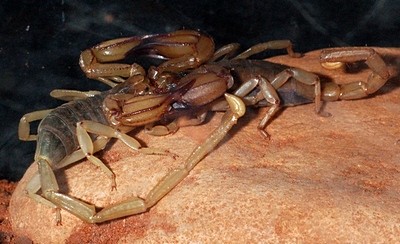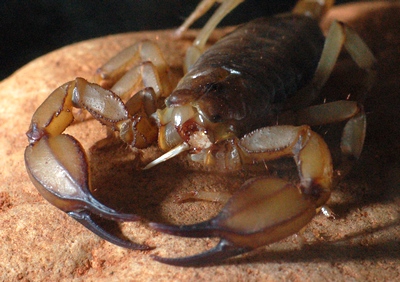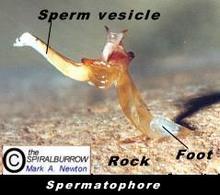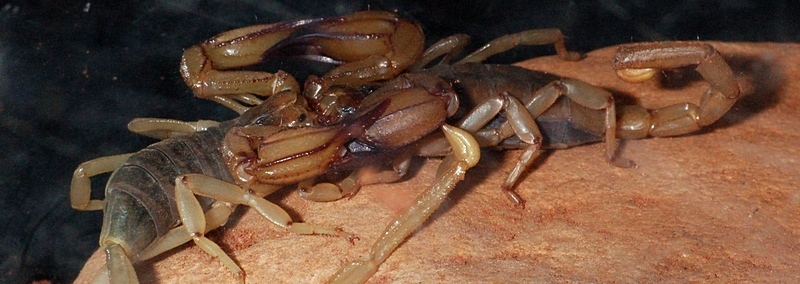Scorpions have a most unusual method for the transfer of genetic material between the sexes. As is the case with many other organisms such as spiders, fish and frogs, scorpion sperm transfer is external and therefore do not actually mate as such. The scorpion mating ritual is known as the 'promenade-a-deaux'; I will describe the sequence of events as I have witnessed them in Urodacus elongatus, a large species of Australian scorpion from the Flinders Ranges of South Australia.
The male scorpion is usually the sex to actively seek out the other for the mating ritual. Using airborne pheromones the male picks up the scent and heads off in search of a mate. When encountering a female the male starts a behaviour called juddering which appears to send a sexual signal to the female, as she then responds with juddering. While juddering (shaking the body back and forth) the scorpions may also tap their pedipalps against the ground - as scorpions can detect ground vibrations this may well be a species recognition behaviour. The female will respond with a similar juddering, approaching the male and sometimes attacking quite aggressively in this species.

Behaviour
A desperate unmated female attempting to mate with another female.
The male of this species has a very long tail compared with the female and for a very good reason. The female is quite aggressive and will not hesitate to kill the male. The scorpions fight with each other, locking pedipalps. The female tries hard to inflict a fatal body sting to the male. The male holds the female at arms length and brings over his very long tail. She cannot reach the male with her shorter tail and is stung in the hand or arm by the male's aculeus. Once being stung and receiving venom the female becomes drugged and no longer wishes to kill her mate. This behaviour is know as the sexual sting and brings about the sexual dimorphism of the males extremely long tail. She then becomes easy for the male to control, and control is exactly what is needed for a successful sperm transfer.

Sexual Sting
Once the male manages to administer the calming sexual sting the promenade-a-deux gets underway.
The male continues to drag the female around until he locates a suitable surface on which he can deposit his spermatophore. The spermatophore is the container that houses the sperm and is placed onto a rock from the male's genital opening. Special sense organs called pectines sweep the substrate below in order to locate a suitable deposition surface. The correct surface is vital, if the male chooses a surface too rough the spermatophore's foot may not be able to stick well enough for transfer to the female, losing the all important genes needed to produce the next generation. The male's pectines sweep across the substrate in a brush like manner detecting the regularity of the surface and surface texture. Not only must the surface be correct, but the male must be able to keep the female in perfect alignment with his own body.
When the male is happy with the surface conditions the spermatophore is released from his genital opening and carefully placed onto the substrate below. The very sticky foot of the spermatophore adheres to the rock and remains upright. The male with his body now strongly arched must very precisely pull the female in a direct straight line so her body and genital opening are directly over the spermatophore. The female's genital operculum or plate is at 90 degrees to her body allowing the genital opening to be exposed at a maximum. With the spermatophore at the correct position the female lowers her body allowing the portion of the spermatophore containing sperm to enter her body. The sperm are released, the female raises her body from the spermatophore and without hesitation the pair quickly break apart, the transfer of the all-important genetic information completed.

Spermatophore consumption
Here a female consumes a spent spermatophore.

Spermatophore
The spermatophore is a package which arises from two halves called hemispermatophores, these are apparently glued together during expulsion. As the female lowers herself the spermatophore inserts and flexes, the flex causes sperm to be released.
